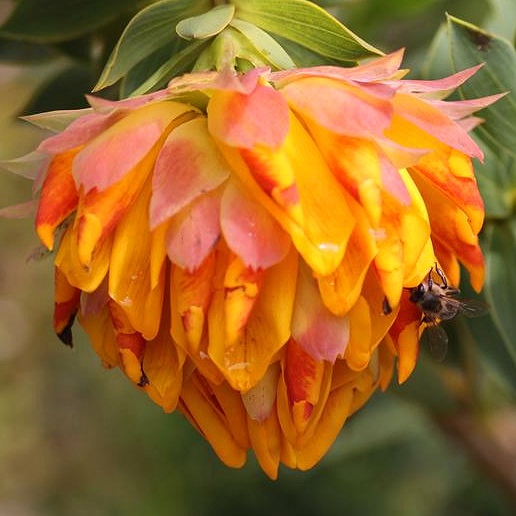"Mountain Dahlia"
Germinating the seeds
When to plant -- Plant your seeds when you receive them for best results. Getting started -- Scratch each seed several times over sandpaper or a nail file, to allow water to enter easier. Place the seeds in a small cup of very warm water (not hot enough to burn you), and let it sit at room temperature for 24 hours (not more than 2 days). The seeds will swell to about twice their size, and when they do, remove them and plant them as explained in the next paragraph. If any seeds don't swell in 24 hours, repeat the scraping and place in slightly warmer water. Repeat again if necessary, using hotter water. Most of the seeds should sprout by this point, but plant any seeds that haven't. Soil -- Germinate them in a well-draining, slightly-acidic soil. A typical mix is equal parts of potting soil and perlite or coarse horticultural sand. Do not add lime to the mix. An alternate mix is equal parts of perlite and coco fiber, with granular fertilizer mixed in. Use containers about 3 inches (7 cm) tall, with drainage holes. Fill them with the soil mix without compressing it, place a seed down, and cover with 1/2 inch (1 cm) of soil. Keep the pots between about 68-77 degrees F (20-25 Celsius), and a little cooler at night. Avoid letting them get above 80 degrees F (27 C) for prolonged periods. I recommend placing a minimum/maximum thermometer near the pots, especially if using a heating mat. Give the pots good air ventilation, to help prevent fungal infections. I do not recommend placing them in a propagation dome. Keep them in a bright spot out of direct sun. They can sprout at different times, usually beginning at 4 to 6 weeks, but some may take up to 16 weeks. Light -- Once they sprout, give them bright light, such as morning sun, filtered sun, or strong LED lighting (See: "Growing indoors with LED lights"). Avoid strong sun the first 2-3 months. Watering -- Keep the soil evenly moist, but avoid keeping the soil constantly saturated. Fertilizing -- When they are 7 days old, feed with a small amount of liquid fertilizer using a very dilute dose (1/8 strength). Hydroponic fertilizer is ideal for young seedlings, because it is easily absorbed and complete. After 2 months, you may switch to a granular fertilizer if you prefer. Choose one with micronutrients, and follow the dosage on the package. Growing onward... Climate -- Moderate temperatures are ideal, especially for young seedlings. For the first 6-9 months, try to keep them between about 50 and 82°F (10-28°C). Keep older plants above about 26°F (-3°C), and preferably above freezing. Older plants might be able to handle hot temperatures if nights are cool. Repotting -- Once they are 2-3 months old, gently transfer them to bigger pots. A typical soil mix for repotting is equal parts of coarse horticultural sand, pumice rock, and compost. Or use equal parts of potting soil and perlite. Avoid disturbing the roots when repotting. Fertilizing -- Liparia has low fertilizer needs and should not be given strong doses of fertilizer. Feed older plants about every 3-4 months during periods of active growth with an all-purpose fertilizer that contains micronutrients. Avoid "bloom" fertilizers, or other high-phosphorous fertilizers. Sunlight -- Older plants prefer mostly sunny conditions. Some protection from hot afternoon sun might be needed in warmer climates. Acclimate younger plants slowly to increased sun levels. If any questions come up, feel free to contact me. Have fun growing them! - Jeff Strange Wonderful Things
|
|||||||||


